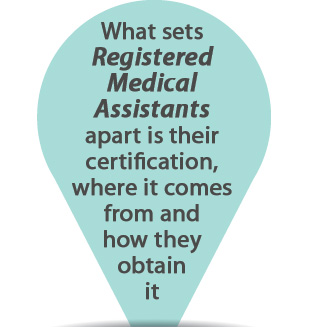 What is a Registered Medical Assistant?
What is a Registered Medical Assistant?
A Registered Medical Assistant carries out clinical, administrative, and other tasks including filing records, prepping lab samples, scheduling appointments for patients, and even taking vital signs – just like Medical Assistants. What sets Registered Medical Assistants apart is their certification, where it comes from and how they obtain it.
What does a Registered Medical Assistant do?
As part of the healthcare system, a Registered Medical Assistant is responsible for a variety of tasks such as:
- Collecting blood, tissue, or other laboratory specimens
- Explaining treatment procedures to patients
- Using tools like hypodermic needles, nebulizers, and spirometers
- Operating medical computer software
- Understanding clerical procedures like transcription and stenography
- Utilizing critical thinking
- Communicating well orally and through writing
- Interacting with patients
RMA Coursework
As a student who is studying to become a Registered Medical Assistant, your classes emphasize science and business aspects. Hands-on skill areas are generally covered, including prepping blood for the lab, patient interaction, and electronic records management. Whether you are pursuing a certificate or diploma at a vocational school, community college, or university, the following are typical classes that you might take:
- Medical Office Administration
- Healthcare Reimbursement, Ethics, and Compliance
- Phlebotomy and Specimen Collection
- Medical Assisting and Infection Control
- Medical Terminology, Human Anatomy, and Physiology
- Computer Productivity Tools and Keyboarding
Pursuing a career as a Registered Medical Assistant could be one of the best life decisions you make. By choosing to pursue a diploma or certificate in an industry that is known for helping others, it is not only altruistic, but also potentially smart. Employment in the health care field and social assistance industry is projected to generate 5.6 million jobs and this increase is the largest and fastest among all major sectors. Just another reason to let us help you start your RMA education today!
Should you become registered?
You may be wondering what the big deal is about certification and whether you should pursue becoming RMA certified. The bottom line: employers prefer to hire certified medical assistants. Furthermore, it could be a great highlight on your resume when you begin interviewing and pursuing your registered medical assistant career. Certification might also reveal to potential employers that you have the necessary skills and education to, not only do your job, but do your job well.
Where do I become registered?
The American Medical Technologists (AMT) is the sponsoring, nonprofit organization that certifies RMAs along with several allied health professions. AMT is accredited by the National Commission for Certifying Agencies (NCCA) which is added assurance that AMT has been evaluated and validated by a review board and found to have met their standards.
After meeting the AMT basic qualification to apply for certification, that you are a recent graduate of, or be scheduled to graduate from, an accredited medical assisting program, you can choose from five pathways to become AMT certified. You can visit AMT’s website. Other resources, like online practice exams, forms and documents, and brochures and flyers, are available on the AMT website, too. Here is bit of basic info on the Registered Medical Assistant:
- First RMA exam was offered in 1972
- Applicant should be a recent graduate or scheduled to graduate from:
- A medical assistant program that holds program accreditation by (or is in a postsecondary school or college that holds institutional accreditation by) the Accrediting Bureau of Health Education Schools (ABHES) or the Commission on Accreditation of Allied Health Education Programs (CAAHEP), or
- A medical assistant program in a postsecondary school or college that has institutional accreditation by a regional accrediting commission or by a national accrediting organization approved by the U.S. Department of Education, which includes a minimum of 720 clock-hours (or equivalent) of training in medical assisting skills, or
- A formal medical services training program of the United States Armed Forces, or
- Applicant shall have been employed in the profession of medical assisting for minimum of five years, no more than two years as an instructor in the postsecondary medical assistant program. Employment dates must be within the last five years, or
- Applicant has passed a general medical assistant certification examination offered by another medical assisting certification agency and who has been working in the medical assisting field for the past three out of five years and who has met all other AMT training and experience requirements (no further examination required)
- Recertification requires 30 points every three years for individuals certified on or after January 1, 2006
- Individuals certified prior to January 1, 2006 (except individuals initially certified prior to January 1, 2006, but who are reinstating after three years of inactive status), are not required to participate
- If certification has lapsed longer than five years, but less than 10, the RMA – plus other recertification requirements – must submit proof of a refresher course
- If certification has lapsed longer than 10 years, the RMA (AMT) must recertify via exam
